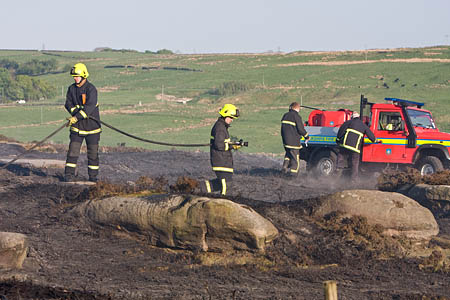Outdoor enthusiasts are being warned to be on their guard against wildfires after blazes destroyed Pennine moorlands.
Large fires swept across the hills above Littleborough, Todmorden, Hebden Bridge and Cragg Vale over the recent bank holiday weekend, destroying wildlife habitats.
And experts said the South Pennines are still at risk of fire following a spell of drier weather.
The South Pennines, between the Peak District and Yorkshire Dales, have expanses of moorland which support rare species of bird such as merlin, short-eared owl and twite.
The area’s Fire Operations Group chairman Danny Jackson said: “Spring is a real danger period for moorland wildfires, which is why the partners working together through FOG, including firefighters and landowners, are asking members of the public to be extra vigilant when out in the countryside.
“The negative impact of wildfires across the moors is widely recognised, including the economic impact on farmers through the loss of grazing.
“The loss of habitat and the effect that these fires have on nesting birds, such as the endangered twite, can also clearly be seen but in addition we want to highlight the hidden dangers: the pollution, the release of carbon into the atmosphere, and the impact on people’s health.”
Between 1 October and 15 April some controlled burning by landowners takes place, but a fire started outside of these dates is a wildfire and any person caught starting one can be prosecuted for arson.
Robin Ward, wildfire officer for the West Yorkshire Fire and Rescue Service, said: “Please be very careful when you are out on the moors.
“Dispose of any glass bottles and cigarettes in a responsible manner and remember to use your barbecue at home rather than on the moors.
“If you see a wildfire please report it through the 999 service giving its location as precisely as possible. And we would also ask people to report anyone acting suspiciously.
“Until recently moorland fires were seen as a low priority but now the uplands are recognised as being as valuable as bricks and mortar.
“If the peat burns it can be very difficult to extinguish and these fast moving fires in off-road locations can be tiring for firefighting crews and resource intensive, which means that we may be stretched if fires occur elsewhere.”
The FOG, established by rural regeneration company Pennine Prospects, includes representatives from the three fire services of the area, Greater Manchester, Lancashire and West Yorkshire; the area’s water companies Yorkshire Water and United Utilities, as well as private estates; the six South Pennines local authorities and Natural England.
Mr Ward added: “Through the FOG partnership landowners can see how the fire services operate and how they can assist when dealing with a wildfire. They know the areas well and have their own specialist equipment, such as all-terrain vehicles, as well as additional human resources to tackle fires.
“We are firefighting together.”
The twite, which is an endangered species on the national red list, is badly affected by wildfires. Fires during its breeding season can have a devastating impact said Charlotte Weightman, the RSPB’s habitat intervention officer for the twite recovery project.
“Twite is England’s most threatened songbird with only approximately 100 breeding pairs, the majority of which breed on moorland to the north of the M62,” Ms Weightman said.
“Many farmers in the Calderdale area have been working really hard alongside the Twite Recovery Project to restore meadows and pasture where twite feed so that this enigmatic little finch isn’t lost from England.
“It would be very sad if moorland fires meant that this effort was wasted.”
More than 60 firefighters tackled a moorland wildfire above Cragg Vale, West Yorkshire, on Tuesday, in the second large fire in the area in just three days.
